Hair transplants using AI robots have emerged as a multibillion-dollar business as hair loss among younger people becomes more prevalent. The Chinese mainland market is seeing a boom, with key industry players looking to expand overseas. Shadow Li reports from Hong Kong.
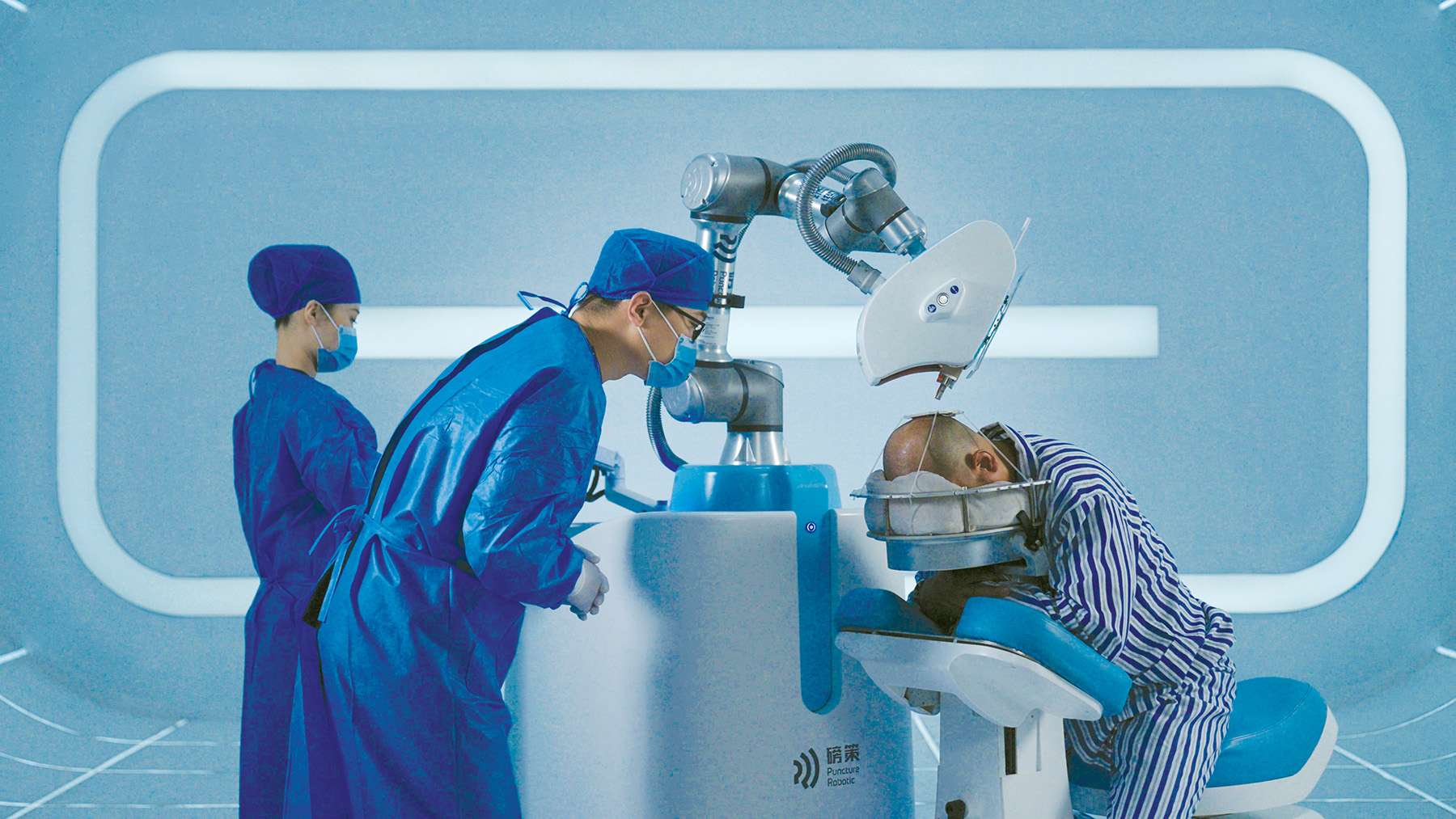
Editor’s note: Embodied artificial intelligence robots are revolutionizing industries worldwide. China’s homegrown AI-powered hair transplant robot is gaining traction, breaking a decade-long monopoly by a US-developed robot.
About a year ago, 32-year-old Hong Kong YouTuber Dino Leung went to Shenzhen on a whim seeking a hair transplant. Initially, he merely wanted to find out how much it would cost — said to be way below what he would pay in Hong Kong. But, after eight years of watching his hairline recede, feeling insecure and devoid of trust, he made an impulsive decision.
He ended up forking out 56,000 yuan ($7,850) for a 10-hour surgery to transplant 5,200 follicles. His video documenting the process, including footage of him in a patient’s gown covered in gauze and riding the metro back to Hong Kong, went viral. It turned out to be one of his best hits with over 252,000 views. A year later, in a follow-up video, he conceitedly showed off his bushy, enriched hairline with a hearty laugh, brimming with confidence.
READ MORE: The bald truth of hair today, gone tomorrow
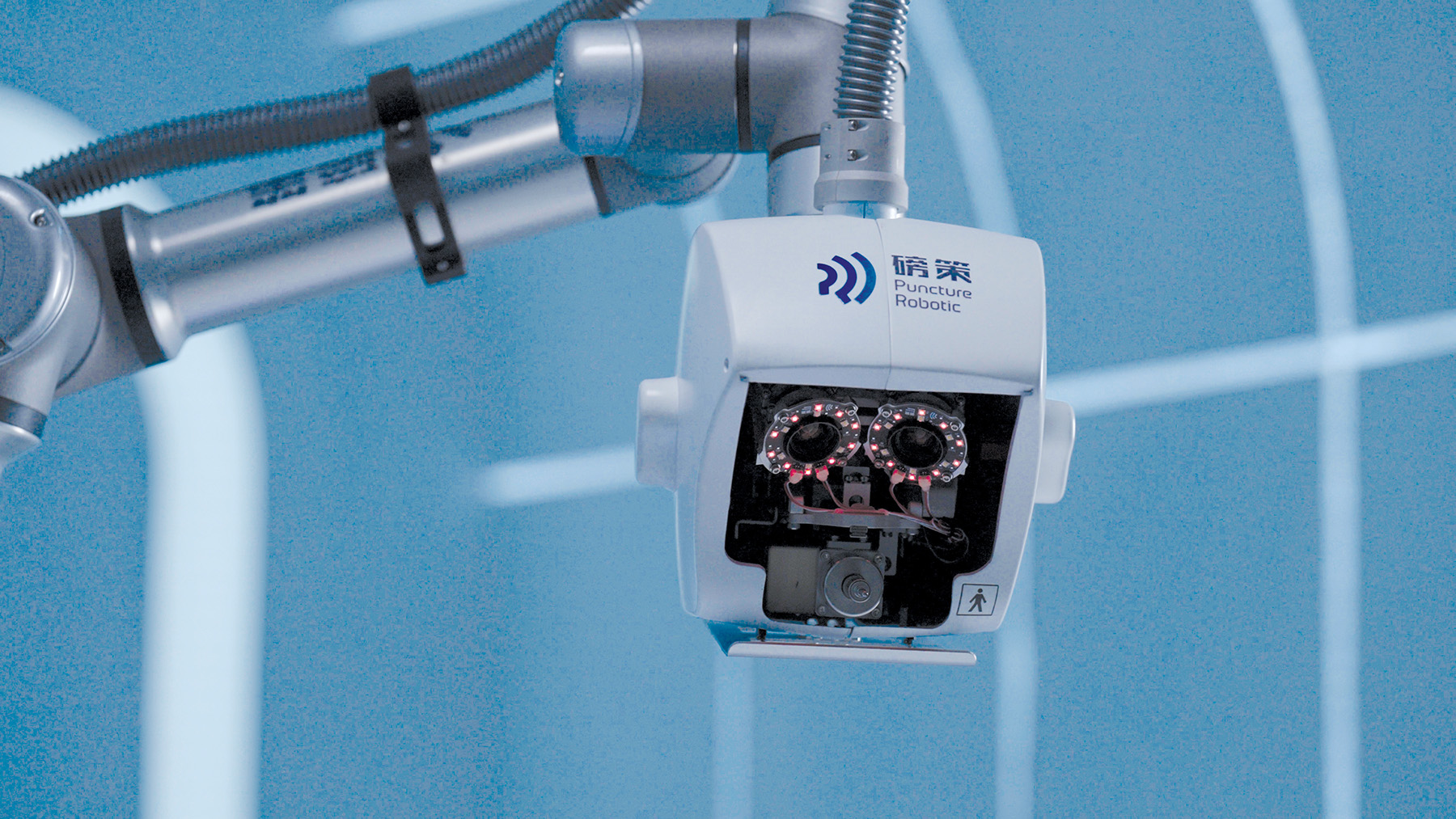
Leung has no regrets, saying it was worth it all although he now has to take medicine for life to suppress the testosterone causing baldness.
Like Leung, hair loss is the bane of many other people, including youngsters. The lifespan of a hair normally ranges from two to five years. On average, a person loses 50 to 100 hairs daily.
An online poll conducted early last year by HairCoSys — a Hong Kong firm specializing in artificial intelligence solutions for the haircare industry — and a local hair products company revealed that 97 percent of 543 people interviewed were troubled by hair or scalp conditions. More than 33 percent of the male respondents said they had been losing hair, with receding hairlines and varying degrees of alopecia.
The phenomenon has fueled a booming market.
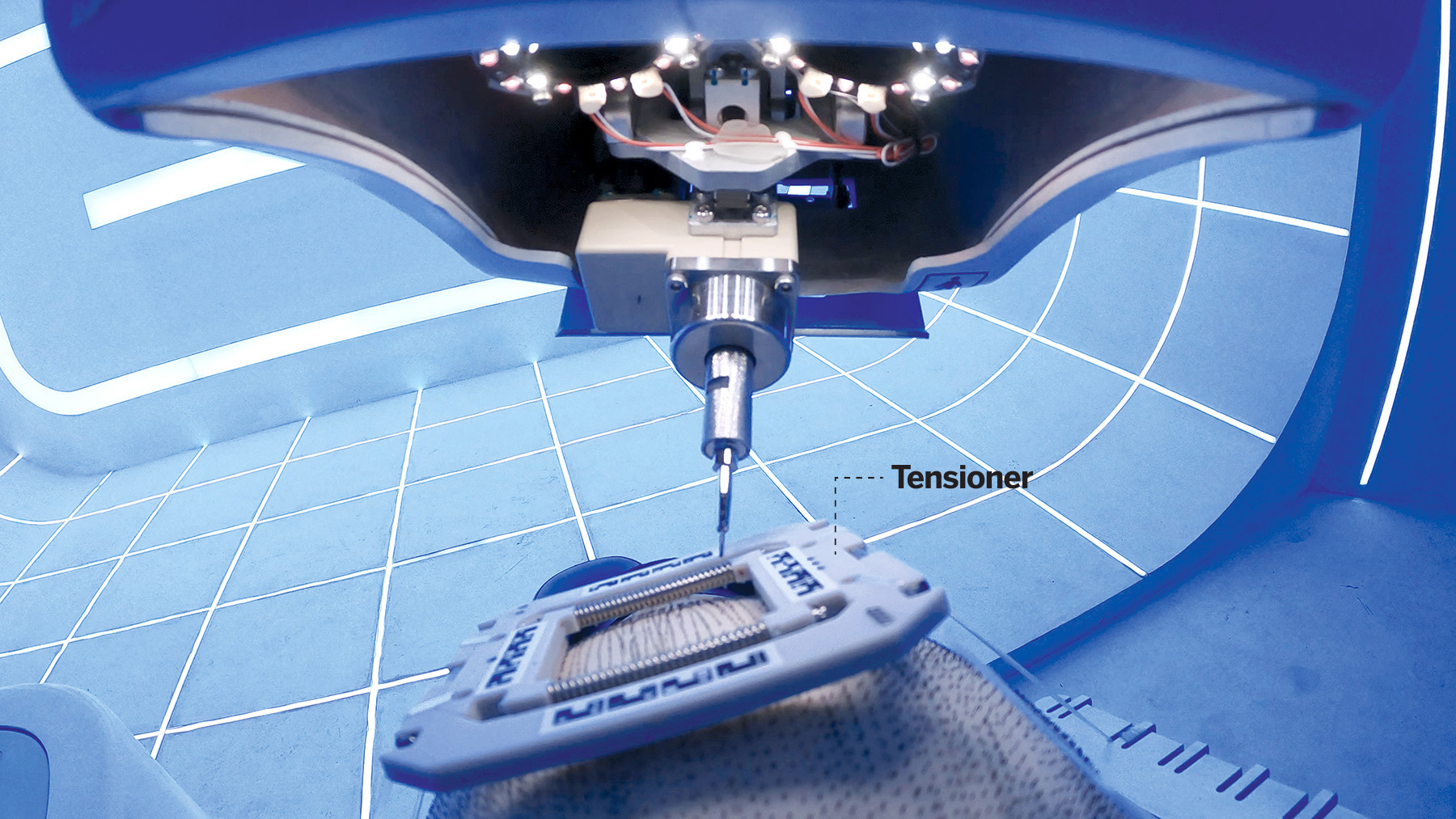
Robots redefine hair transplants
A report by Market Research Future (MRFR) put the value of the global hair transplant market at $7.6 billion in 2023 and projected it would grow to $15.65 billion by 2035, driven by the prevalence of hair loss and people’s growing awareness of new technological developments in robotic-assisted hair transplants.
The Chinese mainland market is witnessing a boom. Yonghe Medical Group Co was listed on the Main Board of the Hong Kong stock exchange in 2021 — the first mainland company providing hair transplantations to go public in the special administrative region.
A separate report by MRFR on China’s hair transplant sector in July put the market’s value at $367.5 million in 2024, projecting it would hit $1.2 billion in a decade. Robotic hair transplantation, which is expected to grow in value from $90 million last year to $216 million by 2035, was highlighted as one of four surgical methods adopted in China to tackle hair loss.
“The advent of robotic hair transplantation has further revolutionized the landscape by incorporating automation and advanced imaging technologies that increase precision, reduce human error, and improve results for patients. This technology’s capability to meet growing expectations for high-quality results positions it as a significant player in China’s hair transplant market,” it says.
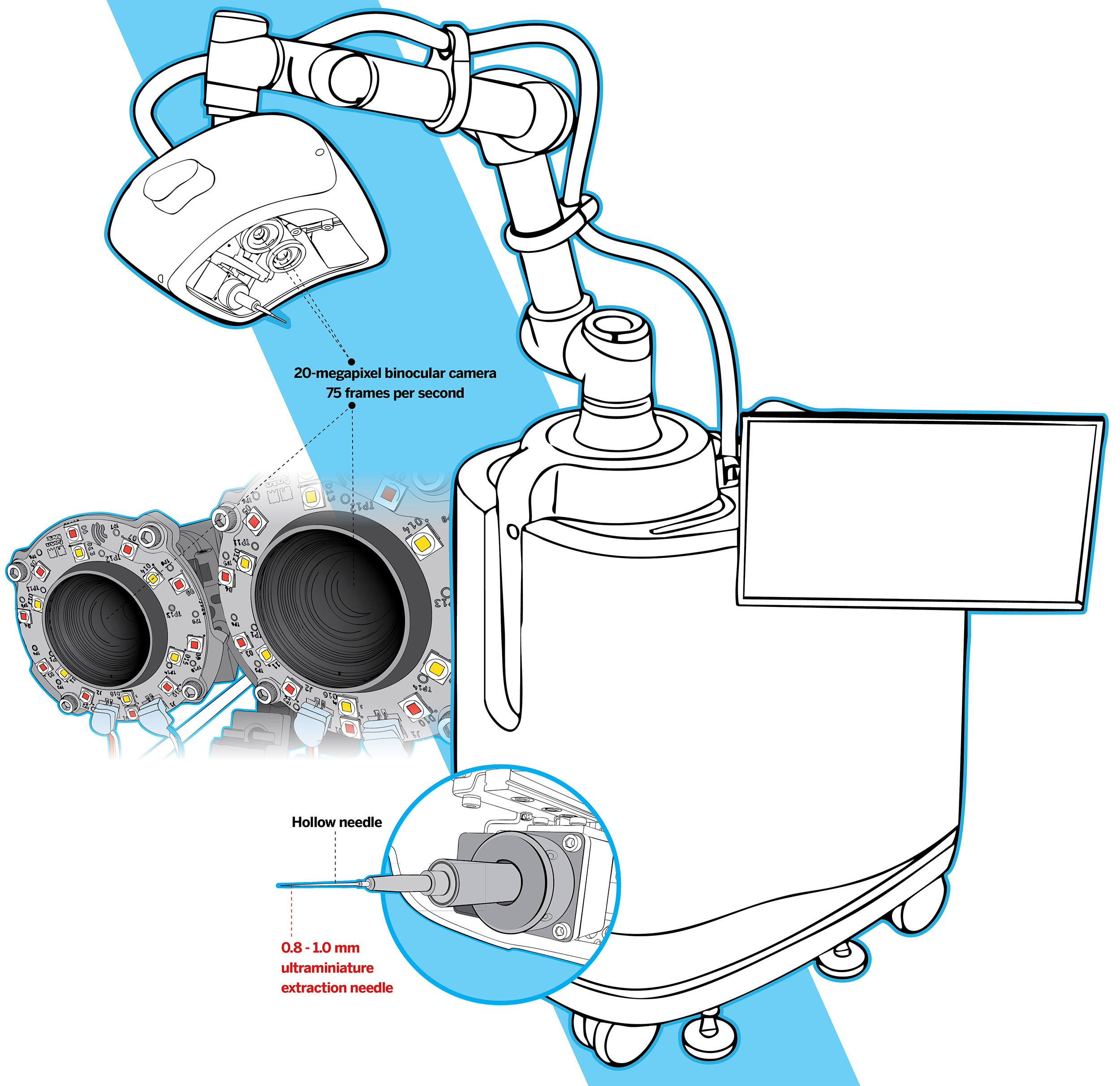
The global hair transplant business has been long dominated by ARTAS which was developed by United States-based Restoration Robotics and approved by the Food and Drug Administration in 2011. The monopoly ended in January when HAIRO — an AI-powered hair transplant robot from Shanghai-based Puncture Robotic — became China’s first homegrown robot to get the green light from its National Medical Products Administration.
According to Puncture Robotic co-founder He Yundi, about 20 to 30 HAIRO units had been sold to institutions by June — 30 percent to public hospitals, including renowned Peking University Shougang Hospital in Beijing, the first Tier III, Class A public hospital in the country to set up a dedicated hair treatment department in 2024.
He says ARTAS’ monopoly wasn’t because of insurmountable technological challenges, but because most medical resources had been deployed to key areas like orthopedics or cancer.
“It’s a niche market for hair transplant robots,” he says. “Developing a robot requires a large market to be cost-effective, making only the US, the European Union and China viable. China is the only market that can develop a similar robot to rival ARTAS,” he adds.
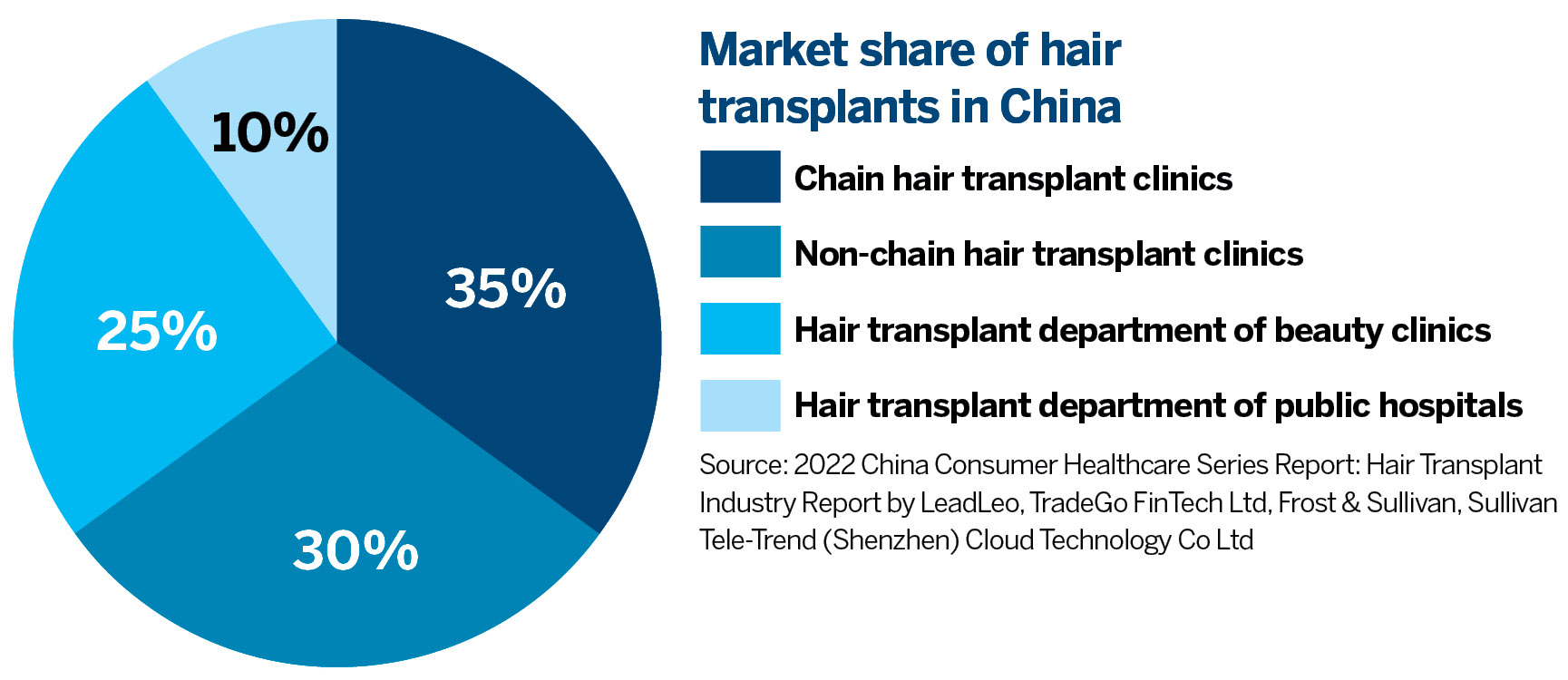
Enhancing surgical precision
The diameter of an ordinary and healthy hair is about 75 micrometers. A robot’s pain point is to extract hair follicles without hurting the hair papilla which is usually located about five millimeters beneath the scalp and unable to be seen from the surface.
“What the dermal papilla is to a hair is (the same as) the root to a tree,” explains He. If the root is damaged, the hair transplanted in the recipient area would not survive as the papilla, part of the hair follicle, contains blood capillaries and nerve endings to supply nutrients to the hair. As the needle pierces the scalp, the skin tissue deforms and shifts mildly, making precise puncturing difficult.
To prevent tissues from shifting and deforming, a saline solution is injected into the scalp to harden it. This will also separate the tissues from the epidermis, leading to less bleeding, says He.
If it’s too deep, the papilla is harmed; if it’s too shallow, the follicle can’t be fully harvested.
This is where AI comes in. The robot is trained to recognize hairs and their inclination.
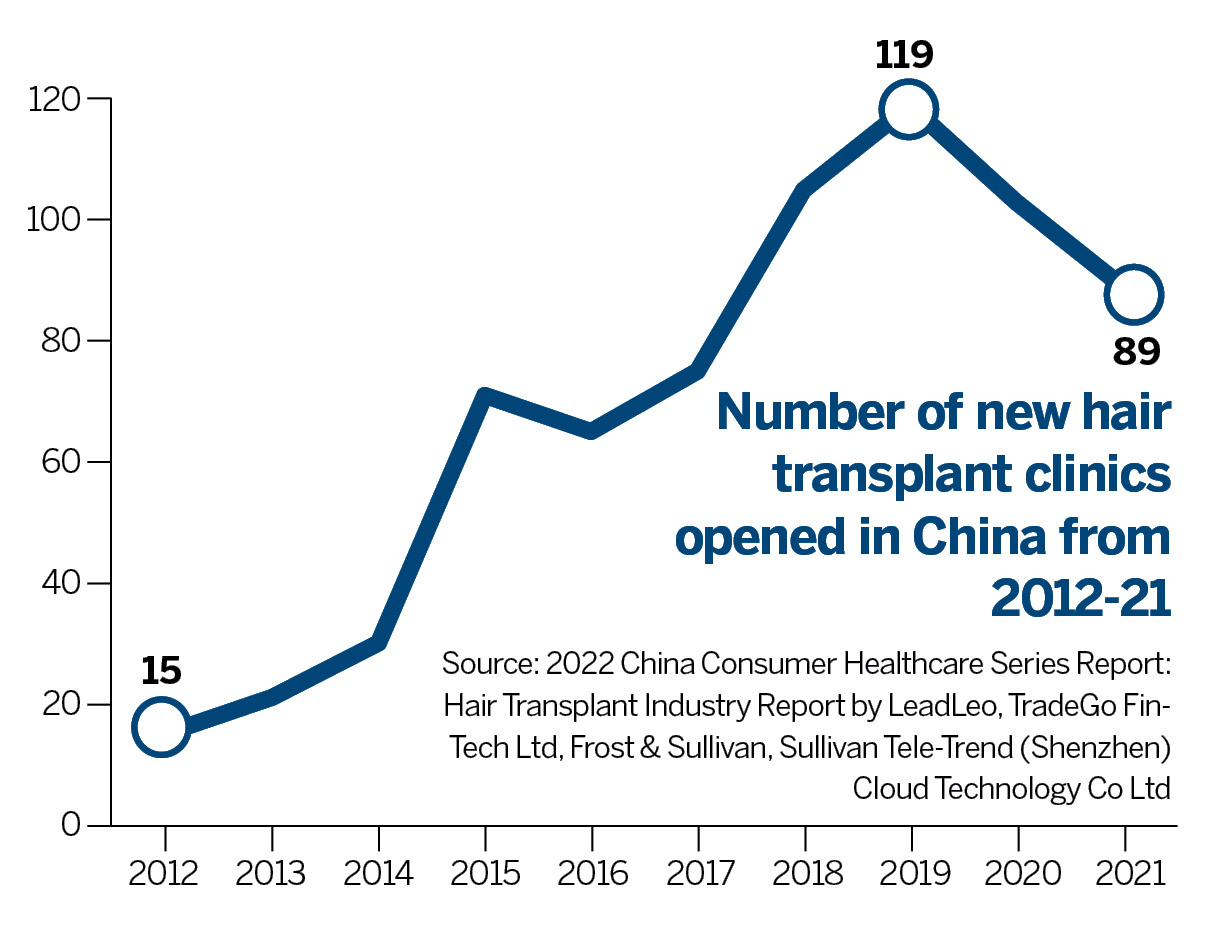
To help the robot identify the donor area precisely, a square frame is placed on the scalp to help it locate the area. Empowered by 20-megapixel binocular cameras and a millisecond-level AI algorithm, HAIRO can precisely find the multistranded follicles. Moreover, AI can prioritize identifying young follicles that are still vibrant. As long as the follicle is still vibrant and alive, hair will grow again even if it falls off. Hair surgeons need to set the parameters and harvest a few hairs to see if they fit as the hair papilla’s depth varies from person to person. HAIRO could be as precise as 0.1 millimeters.
Robotics’ benefits are profound. A traditional hair transplant procedure requires a surgeon to manually extract thousands of follicles — a repetitive, hourslong process that places a heavy burden on their hands, eyes and back. HAIRO can graft 1,800 follicle units per hour, much faster than a human, with a better success rate and less than 7.5 percent of grafts broken. Such automation saves surgeons from physical strain and extends their career.
Feedback from patients shows that the robot-led process is more gentle, leading to faster and better healing. According to He, HAIRO’s AI can prioritize extracting high-quality, multistranded follicles (containing several hairs). When transplanted, they create a bushier look despite the same number of follicles being moved. HAIRO can achieve a maximum multifollicle extraction rate of 95 percent — a feat that’s difficult to accomplish manually.
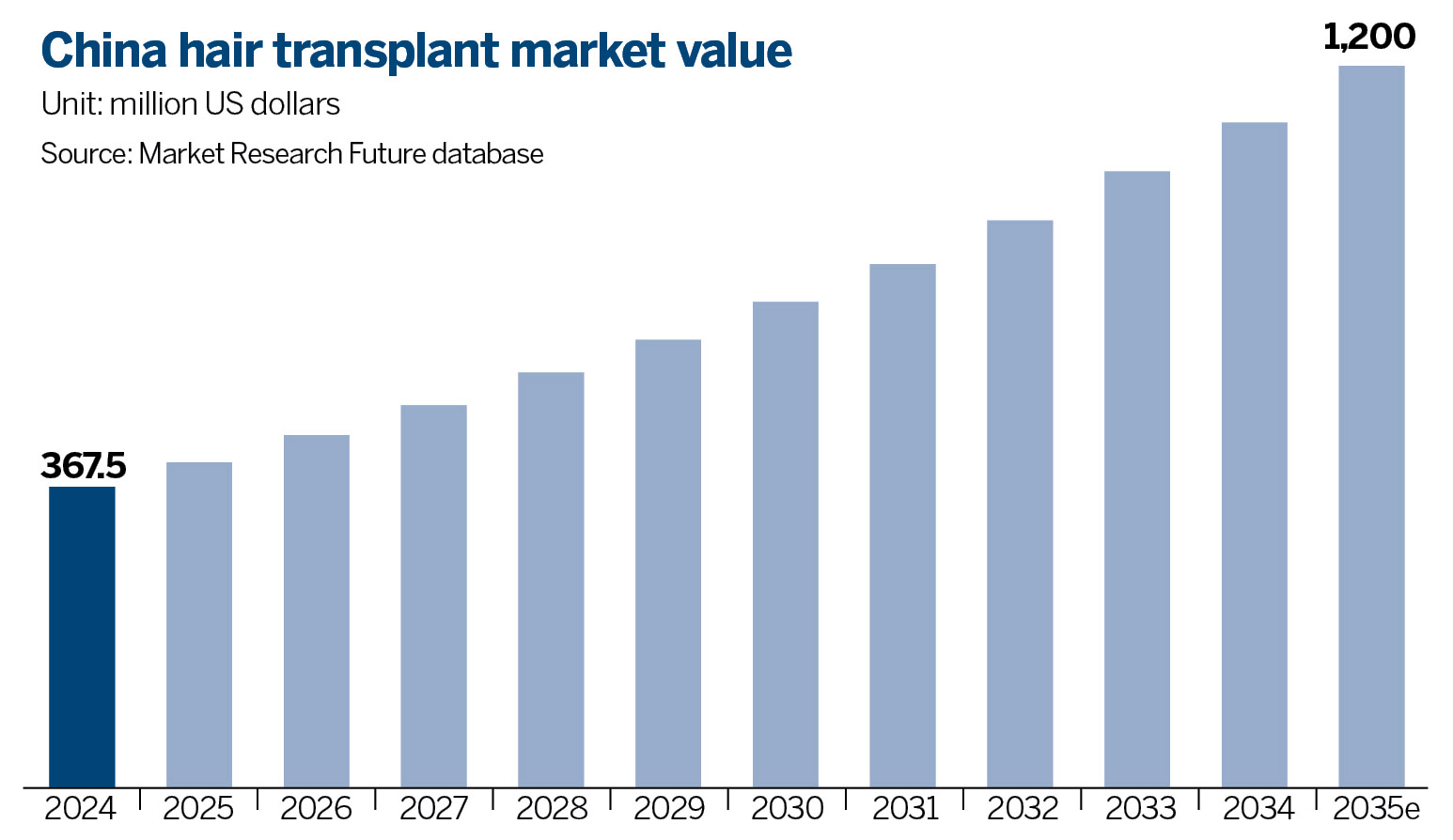
AI can further optimize the harvesting process by dissecting the best follicles in the fastest and most evenly distributed way.
The cost of a transplant is measured per follicle. So, using a robot that extracts more efficient follicles means patients can get better results and pay less.
HAIRO uses a hollow needle with a diameter of 0.8 to 1.0 mm. Normally, the larger the wound, the harder and longer it takes for the wound to recover and chances of having side effects are higher, such as folliculitis.
In the Chinese mainland market, ARTAS was priced from 6 million to 8 million yuan, while HAIRO costs only about a quarter of that amount — a factor that He claims has led to ARTAS’ exit from the market.
Puncture Robotic plans to launch HAIRO in Southeast Asia and Europe, and is applying for CE marking, which indicates a product’s health, safety and environmental protection requirements set by the EU, as well as FDA approval. He expects approval to be given in the second half of next year at the earliest. “It’s a better strategy to have HAIRO in other overseas markets before we can go head-to-head with ARTAS in the US.”
The EU, with its market size and acceptance of higher prices and technology, is seen as the perfect choice for HAIRO’s first stop in its international thrust. Southeast Asia, being geopolitically close to China, has seen its market grow at a rapid pace, expanding along with the demand for new technology and new products.

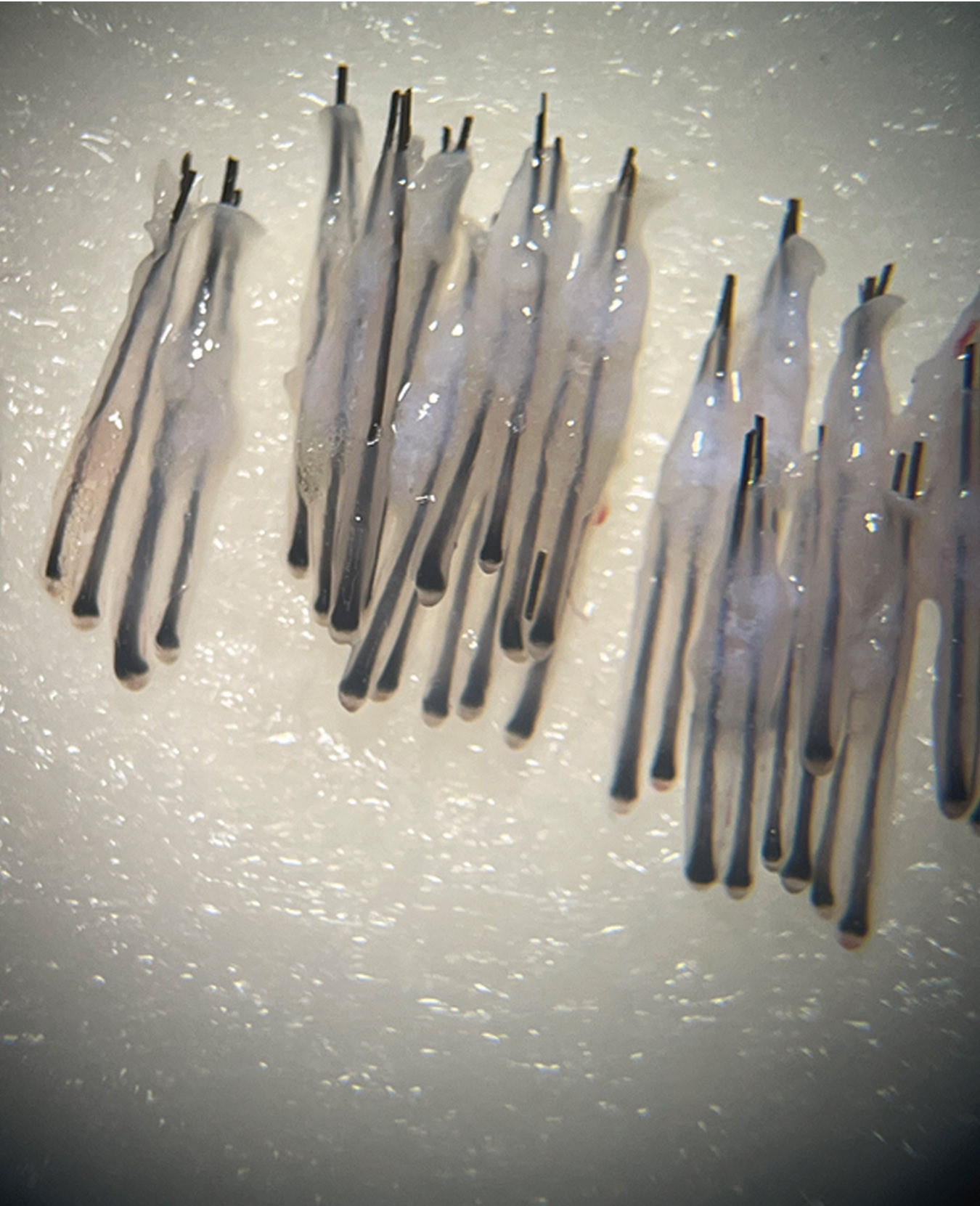
Balancing tech and care
Hair transplant is generally considered a form of cosmetic medicine, a need derived basically for social attributes.
Hair-transplant recipients are mostly aged 20 to 30, with the younger generation seeing a growing trend of hair loss, He says. The reasons for female patients, who might not even be experiencing balding, to choose a hair transplant are primarily to get prettier, while males aim to make themselves look more decent.
Hence, female patients look to fix their hair cracks or hairlines, considered “icing on the cake”, while most male patients are white-collar executives or civil servants who need to maintain a decent appearance for social interactions.
Hair transplants, a minimally invasive, safe and costly surgery, are considered a lucrative business. More public hospitals on the mainland have set up special haircare units, particularly in top-tier cities like Shenzhen, Shanghai and Guangzhou with higher public consumption.
According to He, the waiting time for hair transplant at public hospitals is relatively longer. At Shanghai’s Huashan Hospital of Fudan University, patients normally have to wait for half a year for hair transplant surgery, he says.
There are two primary procedures in hair transplants — follicular unit transplantation (FUT) and follicular unit extraction (FUE). The former method, which leaves a linear scar in the donor area, is now less applied as it involves stripping off a hair-bearing scalp from the back, while the follicle units have to be dissected under microscope and planted them into recipient areas. The latter technique, which means extracting follicle units directly from the donor area, is the mainstream method, with minimal scarring and faster recovery.
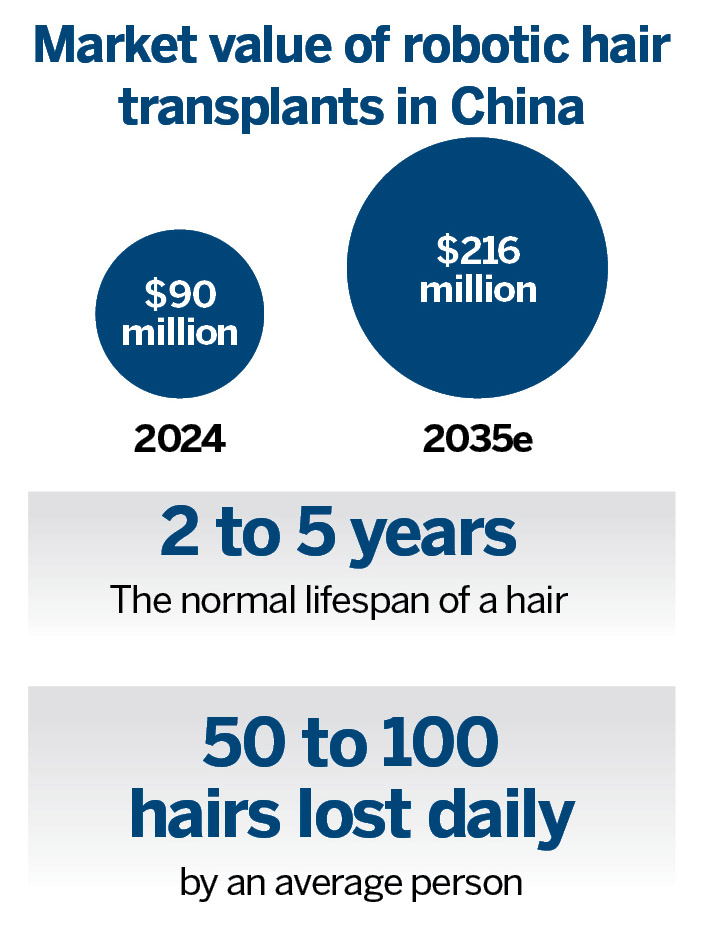
Patients opting for FUE can wash their hair in about three days, while with FUT — with visible linear scarring — it takes longer for them to recover. Yet, using the robot speeds up the process, makes it less painful and promises better healing results.
The wounds from a hair transplant usually heal in about five days and can be hardly seen.
A transplant, which typically involves about 1,500 to 6,000 follicles, involves 2,500 units on average, and takes three to four hours. A session of 6,000 units can take nearly a full day at a hospital.
According to He, a hair surgeon can efficiently operate HAIRO after three surgeries. The hairs at the back and sides of the head are typically the best for transplantation since they are less affected by testosterone — the major cause of baldness among males.
Inspired by the emerging market, Michael Wong Ho-yin founded HairCoSys in Hong Kong in 2021, specializing in using AI to analyze scalp health. His company, incubated at Hong Kong Science and Technology Park, secured a HK$4 million ($513,000) agent deal with distributors in Europe and the Middle East.
Wong’s entrepreneurship was inspired by a selfie with a friend who was ignorant of his own parietal hair loss. “Many people aren’t aware of their hair loss. The earlier they notice it, the better they can act,” he says.
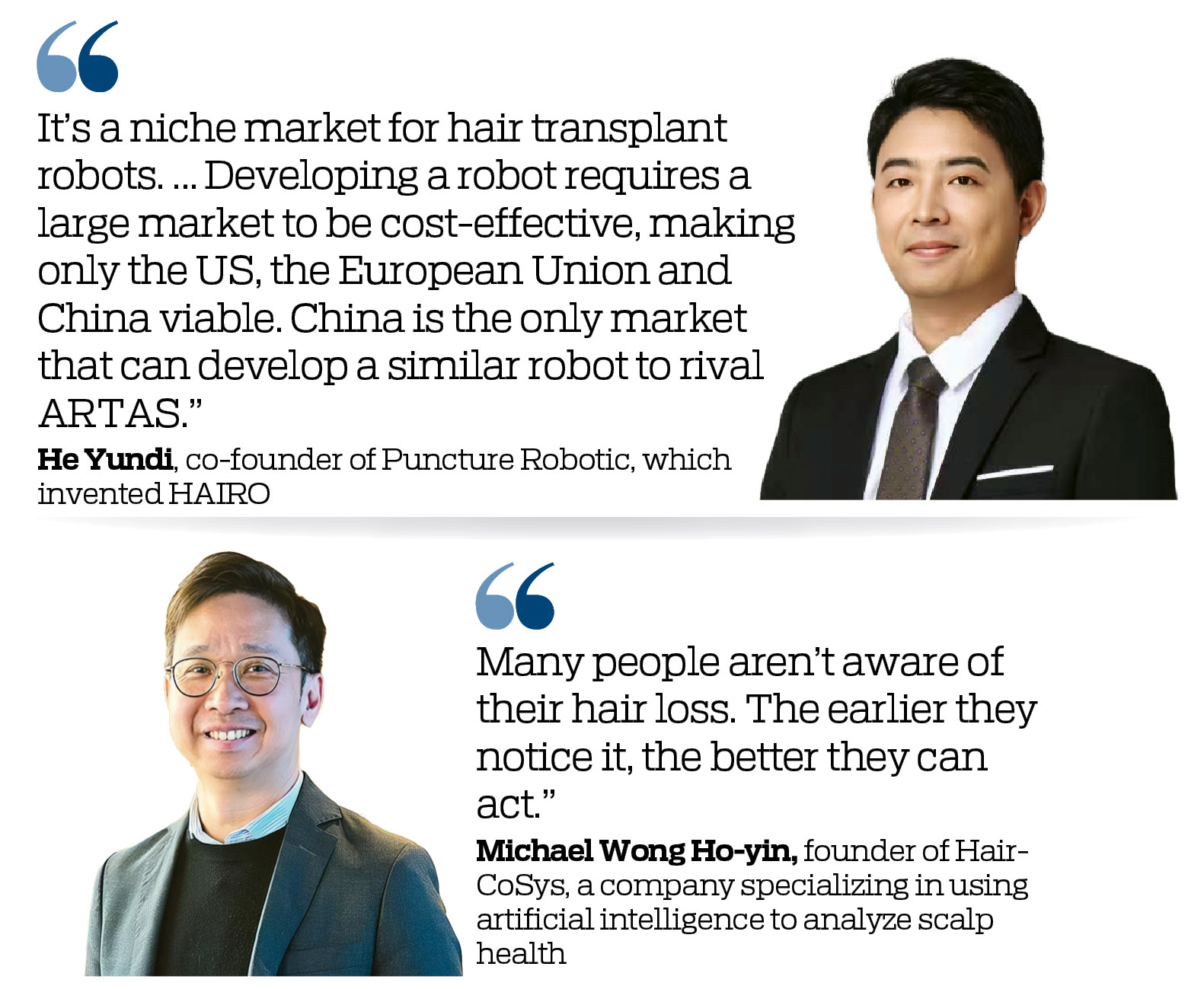
With up to 500 clients, mostly beauty salons, HairCoSys aims to penetrate Belt and Road markets, particularly the fast-growing populations in the Middle East and Southeast Asia.
One downside for hair-transplant patients is that they must shave off part of their hair. To address this, He reveals that Puncture Robotic is developing a next-generation HAIRO capable of planting follicles, which the latest robot of ARTAS is capable of — without having to shave off the hair.
ALSO READ: Male consumers spur medical aesthetics industry in China
“The mainland market is still unsaturated, with many competitors ready to take the plunge,” He says. “Despite the technological advancements of robots,” he believes, “they still can’t replace humanity. A robot can provide a meticulous surgical plan, but not an aesthetic one.”
“The communication and care surgeons offer to patients is beyond that of robots,” He says. “The true value of robots is that they can solve problems that can’t be easily done by humans.”
Core parameters of HAIRO:
- 0.8 - 1.0 mm ultra-miniature extraction needle
- A maximum multifollicle extraction rate of 95% versus an average manual extraction rate of 65%
- 1,800 follicular units/hour fully automatic extraction (around 500 follicular units per hour by hand )
- Wound area reduced by 55%
- Recovery period shortened by 30%
- Millisecond-level AI algorithm that can precisely identify single, double, triple, and quadruple hair follicles
- Identification accuracy: 2.4 micrometer (1/30 of a hair’s diameter)
Contact the writer at stushadow@chinadailyhk.com


